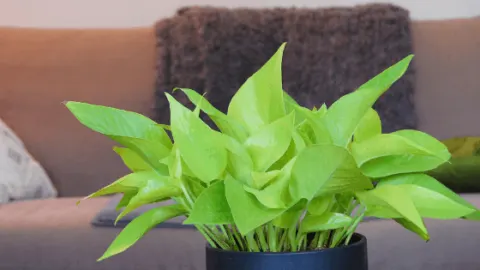You are here to learn all about Pothos care and the Epopremnum aureum ‘Neon’ plant. Pothos is probably the most famous houseplant ever. My mother had one, I have multiple, and you probably have one too.
Neon Pothos
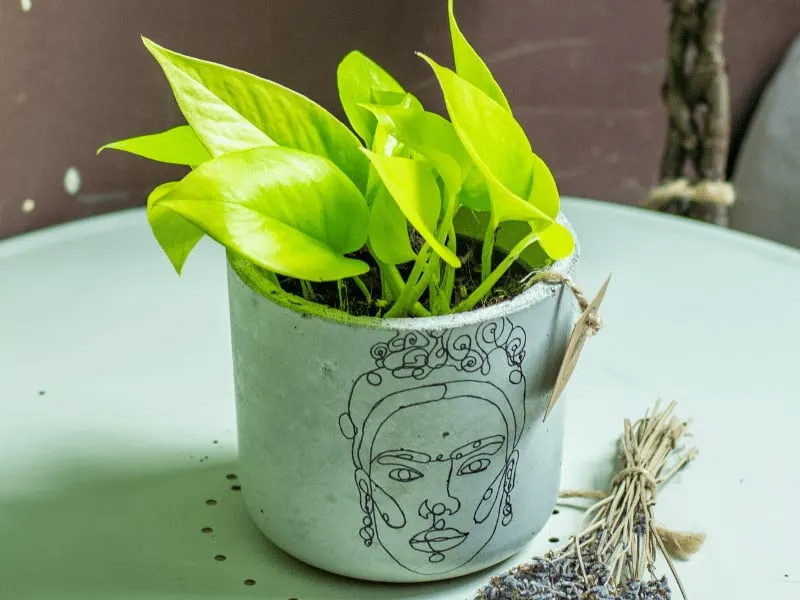
The scientific name of the Neon Pothos Plant is Epipremnum aureum ‘Neon’. It belongs to the family of Araceae. The University of Wisconsin mentions it as one of the variegated Pothos cultivars.
In the woods, Neon Pothos grows in subtropical forests, mostly in Asia and Australia.
It proliferates because it can flourish in pretty dark places hence one of its famous nicknames, Devil’s Ivy.
Like every other Pothos plant, it is a vine and will develop over time.
However, trimming and vertical structural strength can manage its growth pattern.
Its compromising attitude to light has made it a very common houseplant, perfect for starters.
They help improve air quality and tolerate fluorescent light, making them a great option for office environments.
These plants also clean the air.
It’s a straightforward Pothos variety to grow, according to PennState Extension University. I can confirm this as almost all Pothos plants are hardy and beginners. Read more about how to care for the Neon Pothos so it thrives.
Neon Pothos Care Takeaways
| Species | Epipremnum aureum 'Neon' |
| Synonyms | Neon Pothos |
| Family | Araceae |
| Genus | Epipremnum |
| Growth | Climber |
| Height | 40 feet |
| Width | 6 feet |
| Soil | Potting mix or peat moss with added perlite or pumice |
| Watering | Water every 7 to 10 days |
| Light | Bright indirect |
| Temperature | 70 to 90°F |
| Humidity | 60-80% |
| Fertilizer | Fertilize monthly in spring and summer |
| Propagation | Stem cuttings |
| Toxicity | Toxic to humans, cats, and dogs. Contains calcium oxalate crystals. |
Neon Pothos Care
To care for Neon Pothos provide a temperature between 70-90°F (21-32°C). Grow this houseplant in well-draining potting soil using peat and perlite. Keep the soil evenly damp, but not soggy. Water every 5 to 7 days. Use a balanced liquid fertilizer monthly in the growing season. This plant tolerates lower humidity but grows best in a humidity >50%. Bright indirect light is best.
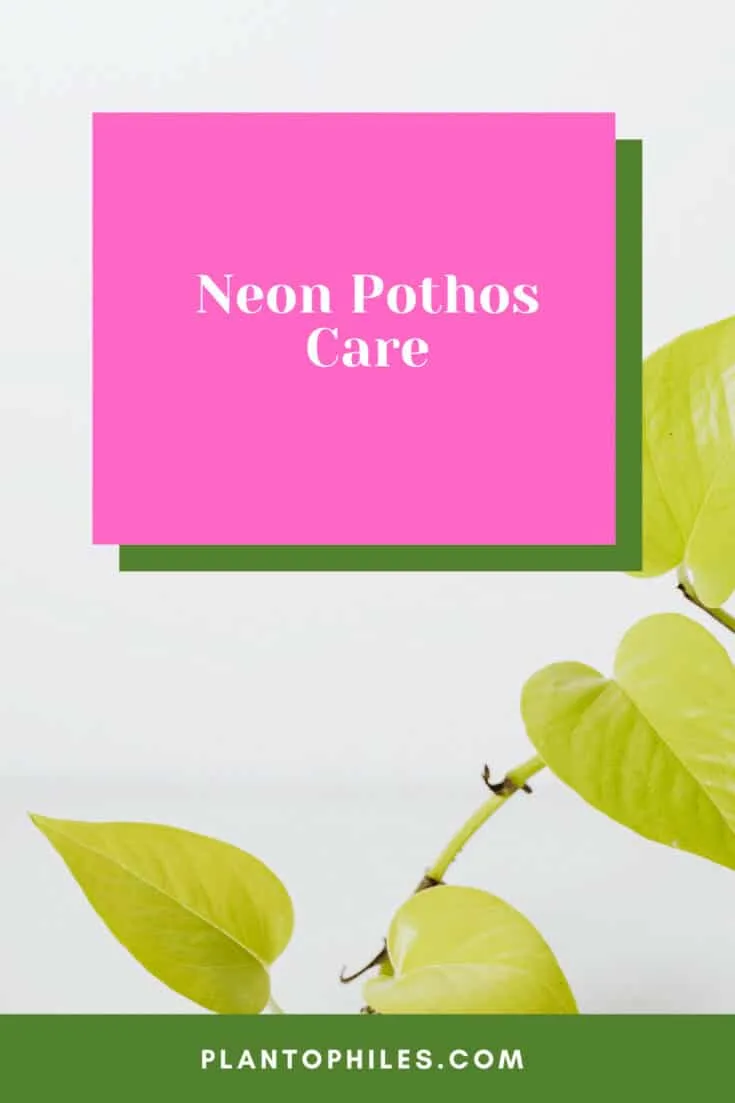
Table of Contents
Read more about the best 10 Neon houseplants.
Soil For Neon Pothos
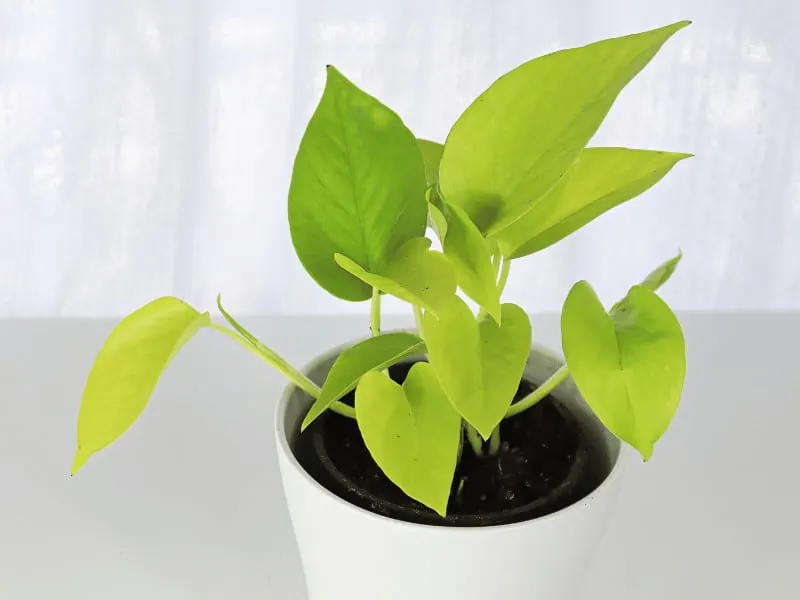
The Neon Pothos soil mix needs to be well-draining. Choose a potting mix containing peat, perlite, and regular potting soil. I do not recommend putting moss into the potting soil as it can stay too wet.
Pothos enjoy a pH of 6.1 to 6.5 but will not have too much of an adverse reaction if the soil pH is slightly below this range.
It is worth noting that although Neon Pothos can grow in water, their roots respond negatively when transferred to soil.
Water-grown Neon Pothos need to develop soil roots first as they developed water roots.
Neon Pothos Watering Schedule
Water your Neon Pothos just enough to maintain the soil moist but not soggy or saturated.
Organizing a watering schedule will help you stop over or underwatering your Neon Pothos plant.
Don’t be concerned if you forget to water them; they can tolerate the occasional missed watering.
Allowing the Neon Pothos to sit in waterlogged soil will result in wilted and yellow leaves.
One trick to decrease the risk of root rot is to let the plant drain after watering and then clean the tray under the pot.
Use containers with drainage holes to help your plant eliminate excess water.
Neon Pothos Light Requirements
Neon Pothos can adapt to low light but thrives in bright, indirect light.
Harsh, intense sunlight will burn the leaves, while too little sunlight will cause the leaves to turn pale green and smaller.
Choose a spot near a window with bright and indirect sunlight indoors. An eastern or western-facing window is ideal.
The leaves will lose their variegation if you put your indoor plant in a dark room or dark corner.
With little light, the development and health of the plant decline. However, they are tolerant of different lighting conditions and will adapt.
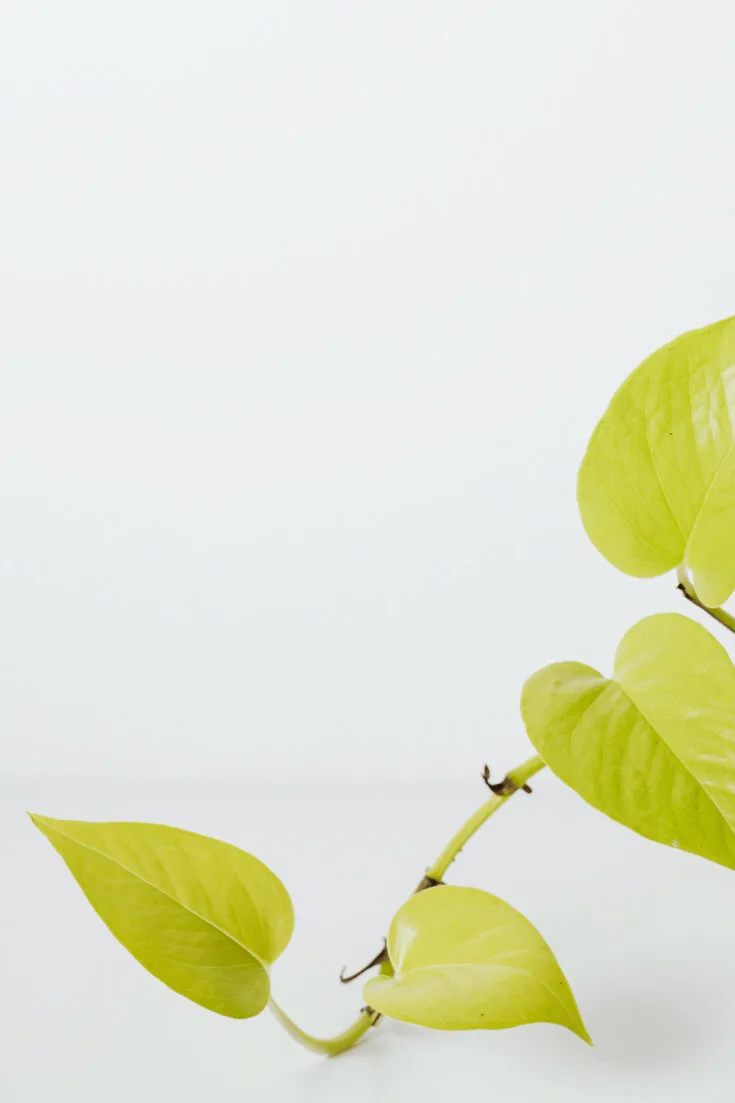
What is the Ideal Temperature for Epipremnum aureum ‘Neon’?
Neon pothos grows best at a temperature between 70-90°F (21-32°C).
Neon Pothos is indigenous to the Solomon Islands.
Thus, it makes sense that these plants embrace high humidity and temperatures between 70 and 90 degrees Fahrenheit.
Ensure that the place where your house plant is located is within this range of temperatures.
Neon Pothos can thrive and grow faster in such temperatures but can tolerate temperatures as low as 55 degrees Fahrenheit.
Something below that, and you’ll find that your houseplant has stunted growth and leaves that begin to turn black.
Neon Pothos Humidity
Neon Pothos grows best in high humidity above 50%.
Therefore, your bathroom or kitchen would be better because Pothos works best in a slightly more humid setting.
Brown leaf tips can mean that the atmosphere is too dry.
Neon Pothos will survive in low-humidity levels. But since they are tropical plants, they prefer high-humidity conditions.
If you assume the plant’s appearance is strained due to lack of moisture, fill the saucer with pebbles and water.
Alternatively, you can use a humidifier to increase the indoor humidity for your houseplants.
Place the plant on the pebbles, but ensure to have drainage holes and the pot’s base is not immersed in water.
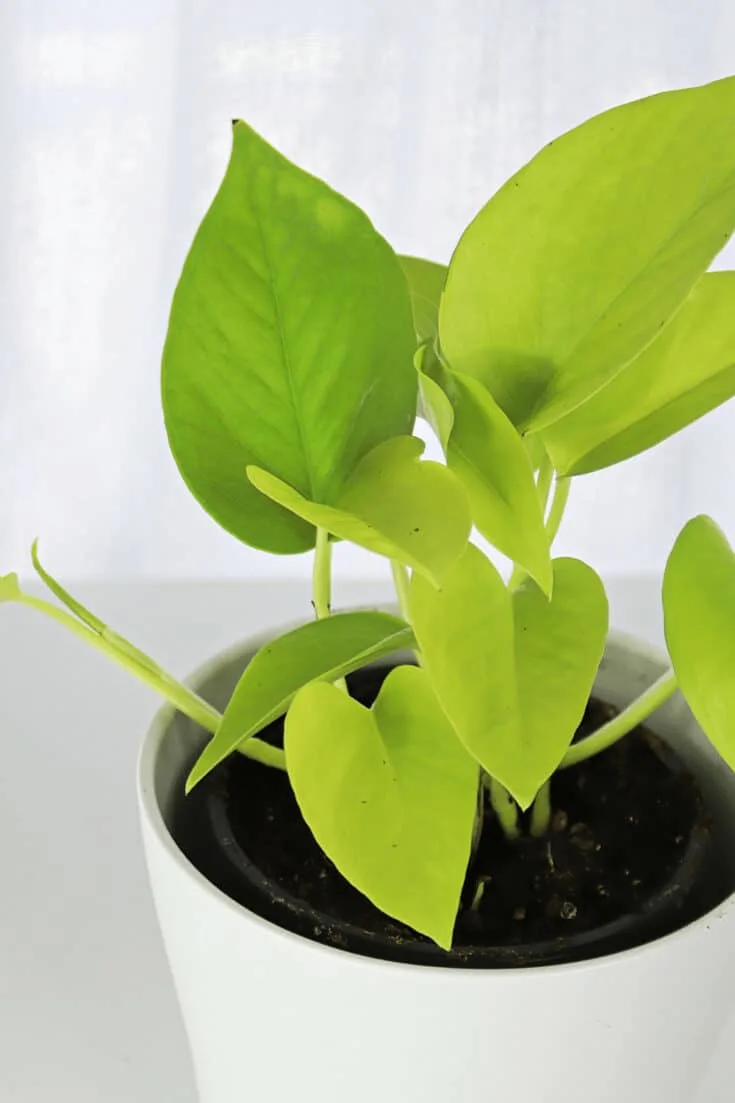
How often should you Fertilize a Neon Pothos?
The Neon Pothos plant should be fertilized monthly using a balanced fertilizer in spring and summer.
Do not fertilize in autumn and winter or reduce it to every other month.
This will maximize the growth rate and ensure your plant grows and evolves as rapidly as possible.
A balanced houseplant fertilizer works perfectly.
If you’re not sure that your soil needs fertilizer, you can evaluate it.
Some gardening shops offer home soil testing kits to determine what nutrients are included or missing in the soil.
Many plants need sixteen nutrients to thrive and grow. Yet many decent fertilizers contain all of these components.
Something important to note is that inorganic fertilizers offer a significant nutrient enhancement to the soil that will stimulate the growth of Pothos almost instantly.
On the other hand, organic fertilizers can take longer to enhance plant growth, but they maintain a healthy medium of production in the long term.
Of course, whichever fertilizer you use, you’ll need to read the package details to ensure you use the right amount for the size of the container the plant is growing in.
Repotting – How often should I do It?
Repot your Neon Pothos every 2-3 years. As the trails keep growing, the roots grow larger.
Water Neon Pothos a couple of days before repotting. You don’t want to stress your plant during this process.
Place the plant on its side and press down the pot to remove the root ball.
Fill the growing pot with the mixture needed to make the top of the root ball even or just below the top of the growing pot.
Repot your Neon Pothos every 2-3 years. As the trails keep growing, the roots grow larger.
For repotting your Epipremnum aureum ‘Neon’ use a pot of about 4-6 inches (10-15cm).
If it grows larger than 6 inches, you can change the pot size to around 10 inches (25cm).
Although pot size doesn’t matter, keeping a note of size will help you better understand which pot to use.
Be sure to have a drain hole in the pot you are using to repot.
You want to get rid of the excess water right away.
Use Pruning To get a Bushy Pothos
You can prune your Neon Pothos by taking cuttings from the stem.
Cut the vine a few inches above each leaf.
The region where the leaf joins the vine is called a node, and after you’ve pruned, your Pothos will send out a new vine in that field.
Take care not to leave any leafless vines. It’s usually better to prune leafless vines.
Keep repeating the same until each vine has been selectively pruned, and the results are visually pleasing.
If you want to do light pruning, you can take tip cuttings on whatever vines are too long.
Neon Pothos Propagation
You can propagate Pothos using stem cuttings:
- Start the method by cutting the vines into small pieces. Use scissors or a pruning shear.
- Cut the bottom leaf to reveal the node and put it in a flowerpot or spread station with water.
- The bare node has to be under the water. And the leaves above water.
- Make sure each cutting has one or two leaves.
- Fresh roots will soon begin to grow. When the roots are about 1 inch (2.5 cm ) long, pot them in the soil.
- You can initiate a brand new plant or even plant it back in a pot that you took out of the cuttings to make a fuller plant.
Pothos Blooms
Like most other Araceae flowers, Neon Pothos flowers are not very showy. It produces a spathe and spadix.
Neon Pothos is Epipremnum Aureum, a wild species of Angiosperm with many developed ranges, and, like all exotic plants of Angiosperms, it blossoms.
But you may not see a flower because it can only flower when it reaches maturity in the right environment and when it seems to have enough light.
Growth – How fast is this Plant growing?
Neon Pothos grow at a moderate rate. New growth will appear every few weeks.
They climb trees in their native climate and can grow to a height of 60 inches (152cm).
That’s why they’re called disruptive, hard to get rid of. That is why they acquired another famous name, Devil’s Ivy.
It is best to provide a moss pole if you want the Pothos to climb. This way, the leaves get bigger and bigger and the plant matures faster. You can also use a hanging basket and let the Epipremnum aureum ‘Neon’ trail.
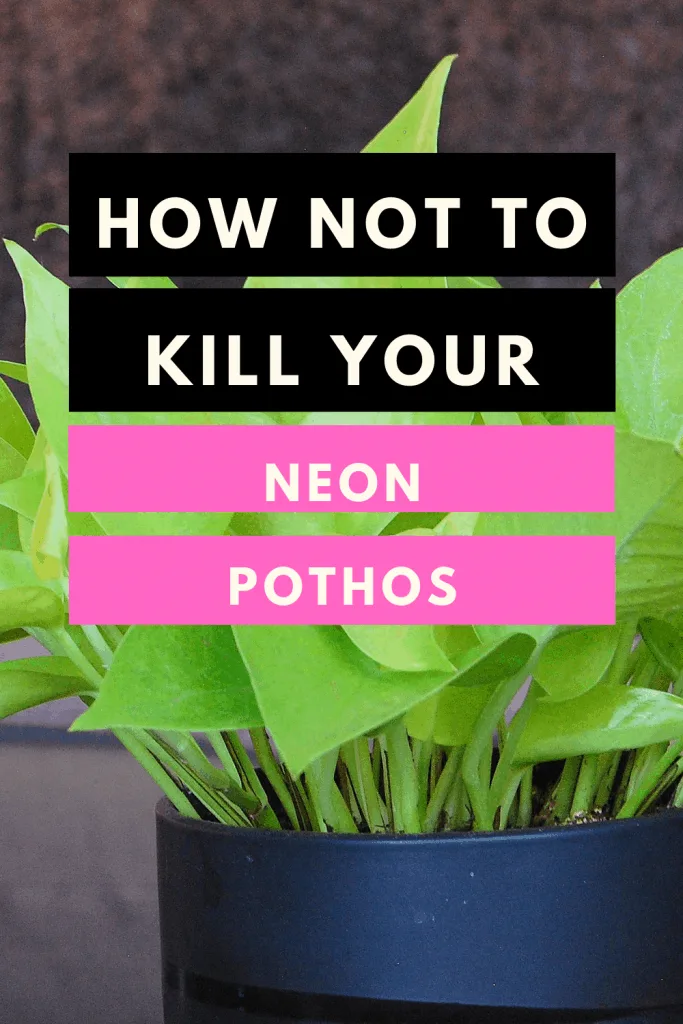
Neon Pothos Pests
Mealybugs are Nasty – They Multiply Quickly
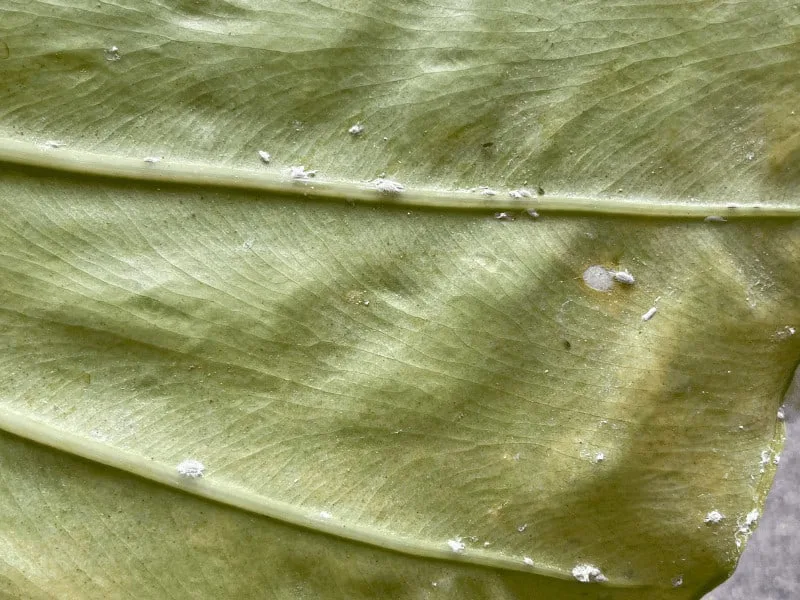
Mealybugs are common insects that infest houseplants. They are pink and have a soft body covered in white, waxy, cottony content.
The white fluff helps shield them from intense heat and lack of moisture.
Its feeding destroys and stunts plants and induces foliar yellowing, defoliation, rotting, and subsequent plant decline. In some cases, the plant gets killed.
The best way to handle houseplant mealybugs is to avoid them from being introduced in the first place.
Thoroughly examine all fresh houseplants before entering your home, and keep them apart from other plants for a week or so.
You can also use rubbing alcohol to get rid of them. Use a Q-tip and apply the rubbing alcohol directly on the soft bodies. The mealybugs will dissolve like this.
Spider Mites Infestation – The Damages is Easier to Spot than the Pests
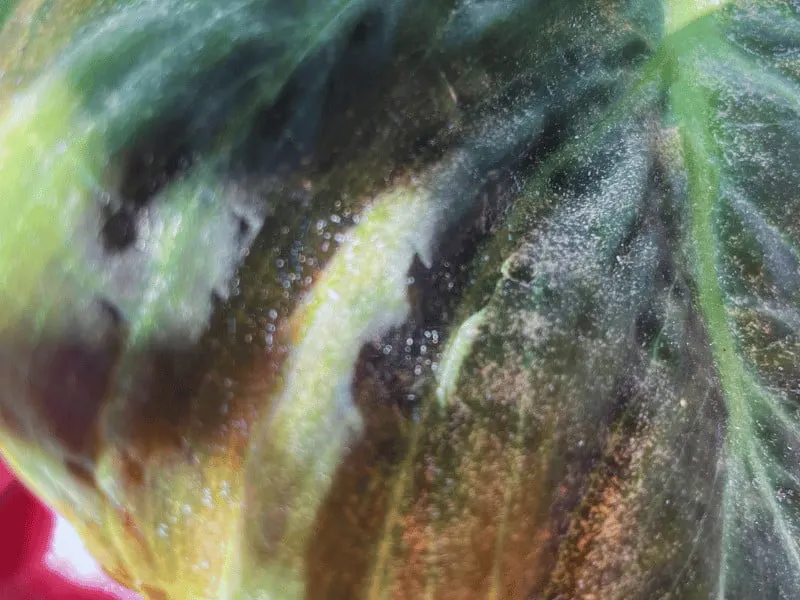
Spider mites are small red insects. Initially, they are hard to spot. Once the infestation gets bigger, nets on your plant leaves and between leaves are easy to spot. They suck the sap out of your Pothos. Leaves will wilt and die. If the infestation gets bad, you can lose your plant.
Use neem oil or a systemic insecticide to get rid of the infestation.
Thrips on your Pothos – The Worst
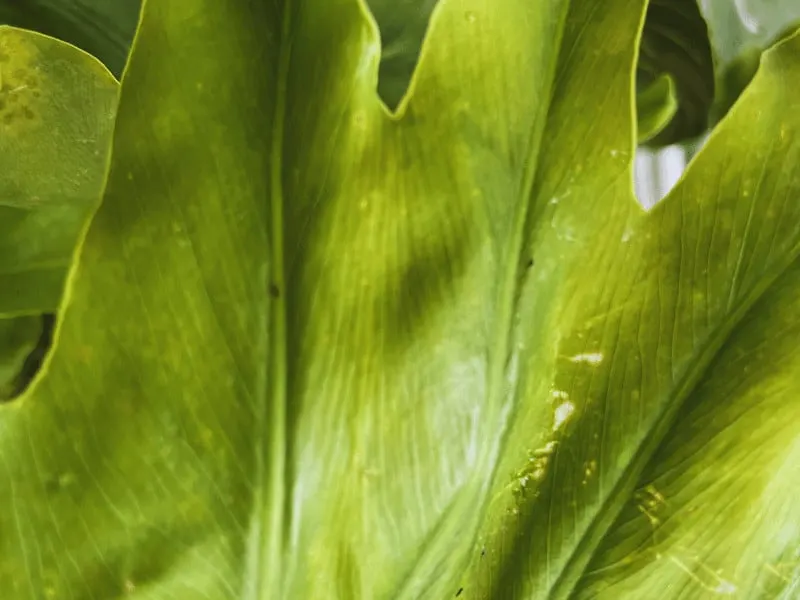
Thrips are the worst. These brown-to-black bugs have an elongated pear-shaped body. They are tiny. The larvae are white and even smaller. Thrips can do a lot of damage. I have already lost several plants. They are also very hard to get rid of.
If your Pothos ‘Neon’ has thrips, I suggest using beneficial nematodes such as Amblyseius swirskii.
Neon Pothos Diseases
Phytophthora
The most familiar disease infecting Neon Pothos is Phytophthora root rot. This disease is often introduced through imported propagative cuttings. Phytophthora root rot causes the leaves of Pothos to turn dark brown or black.
The exemption is the best control of this disease in commercial greenhouse production. Pothos plants exhibiting this disease should be discarded.
Ethylene Damage
In the fall and winter, ethylene damage is most commonly observed.
Ethylene leads the foliage of Pothos to turn yellow, then tan, becoming light brown.
Although soil moisture is sufficient, plants growing look wilted.
Investigate the greenhouse heaters before using it in winter. Make sure there is adequate ventilation in the greenhouse. Carefully apply ethylene treatment options to eliminate them.
Bacterial Wilt Disease
Bacterial wilt disease is usually seen in the commercial development of Pothos at a single-node rooting point.
Infected cuttings fail to root. This disease causes the Neon Pothos leaves to wilt. Veins of stems and leaves turn black.
Bacterial replication is rapid, and an active sanitation program is required.
If an outbreak arises, seeds, soil, and pots should be packed and discarded from the nursery.
Benches and equipment should be sanitized before replanting.
Southern Blight
Clear fungus threads are typically the first sign that the grower has Southern blight.
White, feathery fungal mycelia strands grow along the surface of the soil and up the stems of plants.
Southern Blight will produce oxalic acid, pectolytic enzymes, and cellulolytic enzymes to break the cellular walls of Pothos.
Sclerotia is the principal process by which this fungus survives.
Do not store potting mixes straight on the ground to save your plant from this disease.
A sclerotium can colonize wood chips and soil without requiring a host plant. This disease gains access to the greenhouse through infected soil.
Manganese Toxicity
Manganese toxicity is more prevalent in older Pothos plants that supply cutting materials.
Older Pothos leaves exhibit yellow marking or flecking. Leaves may drop prematurely, and veins darken.
Discontinue fertilization in fertilizer formulations with the element manganese.
Do not add mixed trace elements. Use lime to increase soil pH to a range from 6.0 to 6.5.
Neon Pothos Yellow Leaves
Leaves turning yellow a Neon Pothos are a sign of overwatering. Other reasons can be underwatering, pests, or too much sunlight.
The challenge with Neon Pothos is that the leaves are already yellow. Therefore overwatering can be hard to spot.
When the soil stays soggy for several days, check the roots. Replace the soil in case of mushy roots. Soft roots indicate root rot.
What Causes Brown Leaves on a Neon Pothos?
If whole leaves turn brown, the main cause is underwatering. A different reason for browning leaves is too much sunlight. Direct sun will scorch the leaves. They will wilt.
If the reason is underwatering, stick to a regular watering schedule every 7-10 days. Water thoroughly when watering until water drains out of the drainage holes.
Tips for Growing Neon Pothos
- When you notice the leaves starting to drop, add some water, and the leaves will be straightened in hours.
- The pale leaves mean too much light, and the lack of variegation means too little. Therefore, adjust the lighting accordingly.
- When you plant your fresh houseplant, fill the pot with potting soil that can drain adequately. Also, check for blockages now and then.
- If the Neon Pothos plant has disrupted leaf growth, this may be due to nutritional or light deficiency, pest infestations, or too little water.
Is the Neon Pothos toxic?
The Neon Pothos is toxic to humans and animals such as cats and dogs. Keep it away from pets. You can read more about Neon Pothos toxicity here.
Pothos Varieties
Some other popular Pothos varieties are:
- Golden Pothos (Epipremnum aureum ‘Golden’)
- Marble Queen Pothos (Epipremnum aureum ‘Marble Queen’)
- Jade Pothos (Epipremnum aureum ‘Jade’)
- Manjula Pothos (Epipremnum aureum ‘Manjula’)
- N’Joy Pothos (Epipremnum aureum ‘N’Joy’)
- Pearls and Jade Pothos (Epipremnum aureum ‘Pearls and Jade’)
- Cebu Blue Pothos (Epipremnum pinnatum ‘Cebu Blue’)
- Silver Satin Pothos (Scindapsus pictus ‘Silver Satin’)
- Jessenia Pothos (Epipremnum aureum ‘Jessenia’)
Frequently Asked Questions
How much light does Neon Pothos require?
Neon Pothos adapts to low light but prospers in bright, indirect light throughout the year.
How long does the Neon Pothos plant live?
Pothos vines typically live for 5 to 10 years, depending on their habitat and any life-shortening bacteria, fungi, or insects.
Does Neon Pothos prefer small pots?
Neon Pothos rarely needs repotting and can survive in a smaller container, which also helps prevent the plant from becoming too large. The new pot should often not be more than 2 inches bigger (5 cm) than the old one.
Why are my Neon Pothos leaves turning yellow?
The primary reason for yellowing leaves among Pothos plants is improper soil moisture – especially overwatering. Just water the Pothos when the top 25% of the soil in the container is dry.
Is Neon Pothos poisonous to animals?
This plant produces insoluble calcium oxalate crystals similar to other plants of the Araceae family. Nibbling or chewing into this plant can trigger these crystals, causing tissue penetration and inflammation of the mouth and the GI tract.
Do Neon Pothos like coffee grounds?
As we know, the coffee manure, when unwashed and applied to the soil, is enriched with acidic materials, and this acidic soil level is perfect for the growth of Neon Pothos plants as well.
Why is my Neon Pothos not growing?
Not enough water is a leading symptom of stunted plants in Pothos. If the plant dries to the roots, the growth will be delayed, and the plant’s general health will decline, which can cause disease and insect infestations.
Conclusion About Neon Pothos
While indigenous to the forests of the Solomon Islands, Neon Pothos adapts to a broad spectrum of environmental conditions outside their natural tropical ecosystem and are an easy-care plant.

